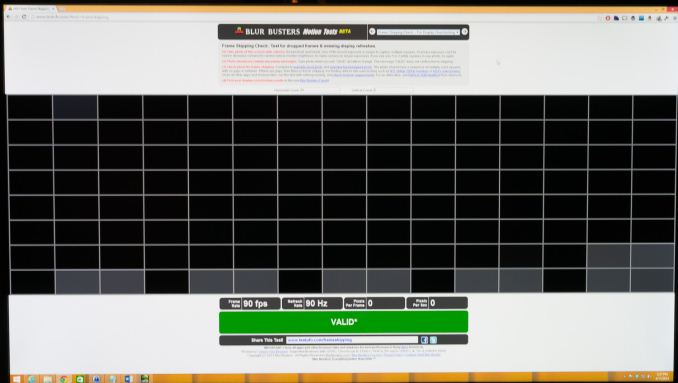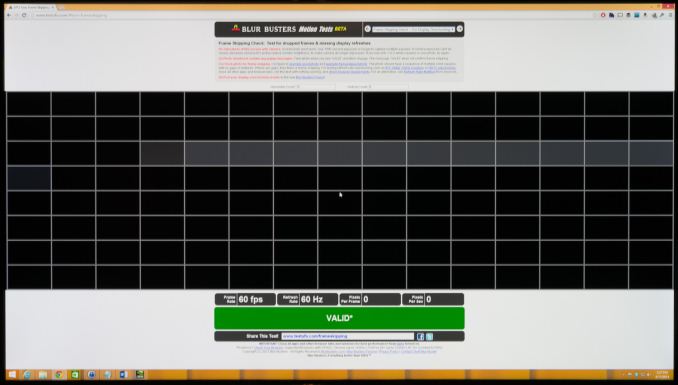QNIX QX2710 LED DPmulti True10 Review
by Chris Heinonen on April 11, 2014 6:00 AM EST_678x452.jpg)
The best thing to happen to the computer monitor marketplace has been the introduction of inexpensive QuadHD displays from South Korea. At a time when a $700 monitor was considered cheap in the United States, these were available on Ebay for around $300 and utilized the same panel as more expensive offerings, though often with a lower grade panel. The introduction of these displays forced mainstream vendors in the USA to introduce more affordable models, and saw other vendors introduce more affordable products as well.
As good as this introduction has been for consumers, I always held back from recommending the displays to most people. One reason is that as an imported product that lacks a US distributor, there was very little warranty associated with them. If you received a model that had issues from a seller on Ebay, the service or replacement options you could expect were really up in the air.
Second, there was no real testing being done on them. A review sample of a foreign, imported product was impossible to get, and just buying them to test isn’t feasible. Now I finally have been offered one of these displays to test, the QNIX QX2710 LED DPmulti True10 (henceforth called the QNIX in this review). With an updated 10-bit panel and a DisplayPort input, it offers more spec-wise than the previous models. Instead of being limited to a DVI input, it also includes DSub, DisplayPort, and HDMI inputs. The panel is a 10-bit model which it accomplishes by being 8-bit with A-FRC to simulate the last two bits. Taking full advantage of a 10-bit panel is hard to do and is usually limited to just a few applications, but being true 8-bit is important.
There is an on-screen menu system that offers adjustments for Brightness and Contrast, color temperature, and a dynamic contrast mode. Enabling the Dynamic Contrast mode disables the Brightness and Contrast controls, while also setting the light output to a retina-searing level. Navigating the menu system is pretty easy overall, though not at the level of the best displays.
There is a pair of 5W speakers built into the rear of the display and they sound like most speakers on the rear of a monitor. Sound is muffled and they’ll work in a pinch, but I wouldn’t want to use them on a daily basis. One semi-interesting feature is that the QNIX can accept a 4K input and then it scales it to 2560x1440. I don’t see a reason to do this with a PC, but with a video device (i.e. a future 4K Blu-ray player, or a video game system) where your output choices are limited to 4K or 1080p, the downscaled 4K image could look better on the QNIX than upscaled 1080p.
The specs suggest that the QNIX can be overclocked to 120Hz by using a custom resolution setting for the video card, but I am unable to make it work in any configurations that I've tried (DisplayPort or DVI, AMD or NVIDIA cards). Going to 110Hz worked fine, but higher settings did not for me. It might be a panel lottery, where some work at 120Hz and some do not, but I wouldn’t assume you will get 120 Hz to work for certain. Still, pushing beyond 60Hz is at least possible.
Update: Commenters pointed out that the QNIX "overclocks" by dropping frames. To test this I used the QNIX on TestUFO.com at both 90Hz and 60Hz and took 1/5 second exposures of the Frame Skipping Check. Below you can see screenshots showing that at 90Hz, the QNIX is simply dropping frames instead of creating extra frames. At 110Hz I began to get sparkles on the screen, obviously pushing the limits of what the panel can do. Because of this, I'd discount any overclocking mentions from the QNIX as it isn't a true higher referesh rate panel.
The monitor stand offers only a tilt adjustment, with no height, pivot or swivel. A nice design cue is the inputs being on the side of the monitor and not on the bottom. Placing them on the bottom makes hooking things up hard and I wish fewer companies would do it, particularly on budget models with no height adjustment.
| QNIX QX2710 LED DPmulti True10 | |
| Video Inputs | HDMI 1.4a, DisplayPort, DVI, Dsub |
| Panel Type | AHVA |
| Pixel Pitch | 0.231mm |
| Colors | 1.07 Billion |
| Brightness | 350 cd/m2 |
| Contrast Ratio | 1000:1 |
| Response Time | 4ms GtG |
| Viewable Size | 27" |
| Resolution | 2560x1440 |
| Viewing Angle (H/V) | 178 / 178 |
| Backlight | LED |
| Power Consumption (operation) | 46 W |
| Power Consumption (standby) | 0.5 W |
| Screen Treatment | Anti-Glare |
| Height-Adjustable | No |
| Tilt | Yes |
| Pivot | No |
| Swivel | No |
| VESA Wall Mounting | Yes, 100mm VESA |
| Dimensions w/ Base (WxHxD) | 25 3/8" x 18 1/2" x 6 3/4" |
| Weight | 10.2 lbs. |
| Additional Features | 3.5mm stereo in, 3.5mm stereo out, 2x5W speakers |
| Limited Warranty | 1 year |
| Accessories | 3.5mm audio cable, DVI cable, power adapter |
| Price | Around $365 via eBay |


_thumb.jpg)
_thumb.jpg)
_thumb.jpg)
_thumb.jpg)
_thumb.jpg)
_thumb.jpg)
_thumb.jpg)
_thumb.jpg)
_thumb.jpg)
_thumb.jpg)
_thumb.jpg)
_thumb.jpg)










85 Comments
View All Comments
cheinonen - Saturday, April 12, 2014 - link
This is the model that QNIX had available for me to review. None of the other models have been made available for review to this point.okashira - Friday, April 11, 2014 - link
Whoa, I just noticed a huge mistake in the article. This monitor can NOT be overclocked beyond 60Hz.It will accept high then 60Hz input, however, it will only result in skipped frames and poor juddery movement.
Stuck with the DP2710LED or QX2710.
okashira - Friday, April 11, 2014 - link
WHy is anand deleting my comments?This monitor is one of the worst of the Korean's. The DP2710LED and the QX2710 are superior.
Also, this monitor is not overclockable. Over 60Hz and it just drops frames. Bad information.
Ryan Smith - Friday, April 11, 2014 - link
"WHy is anand deleting my comments?"We haven't been deleting any comments. As far as I can tell, all of your comments are present and accounted for.
okashira - Friday, April 11, 2014 - link
Yep, sorry about that. I thought comments were sorted by descending date.Badelhas - Monday, April 14, 2014 - link
Ryan, please buy the single dual-DVI input and test it. That is the Korean Monitor you should be testing, not this one ;)Laststop311 - Friday, April 11, 2014 - link
If you keep an eye out on craigslist you can find really good deals and people will usually negotiate. I got a dell u3014 2560x1600 and I only paid 625 including the gas to drive and get it. The outer bezel had some scuff marks but the panel performed flawlessly. It was still perfectly calibrated, almost perfect uniformity and it ran very cool to the touch compared to other monitors.Yes 625 isn't as cheap as basically close to 400 after all is said and done getting a korean monitor. But this is 16:10 and 30" with more pixels. When you are only saving that much though is it worth the risk of dead pixels and crappy build quality and questionable longevity. Keep an eye on your local craigslist's for high end monitors. This is where you'll find the best deal.
I'll be sticking with the dell u3014 for a long time as the only upgrade i can look forward to is one of the 32" 4k UHD monitors and they are way overpriced for quality ones.
Death666Angel - Saturday, April 12, 2014 - link
That was a good deal. At the time I was looking at 1440p monitors, 30" 1600p ones were still going for 750 to 900€. I got my Samsung one for 540€ because of a discount. And besides the refresh rate, it is a super great panel with the right amount of anti glare. I'm looking forward to a 4k model in a year or so, when 60Hz and compatibility of good. :)pierrot - Saturday, April 12, 2014 - link
so the version with less inputs should be just as good in the other areas right?cheinonen - Saturday, April 12, 2014 - link
There's no way to say at all how it would perform. The firmware is different, and as we've found before (look at the two LG 29EA93 reviews), a firmware update can make a monitor completely different. So the panel might be the same, but that's just one part of a display.